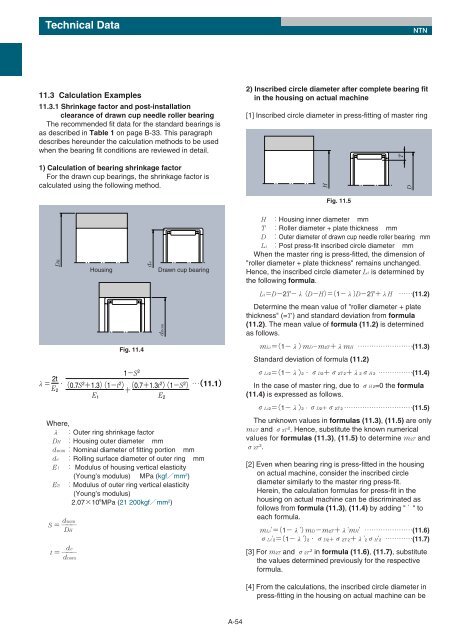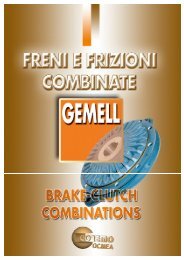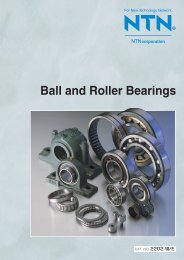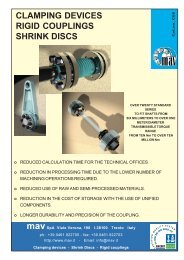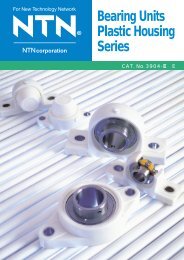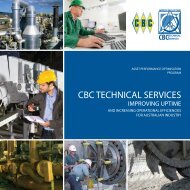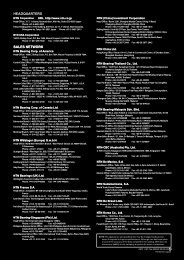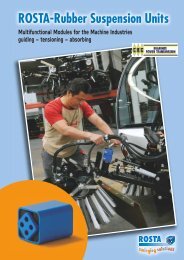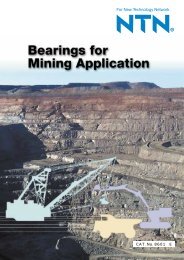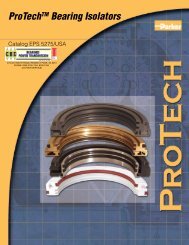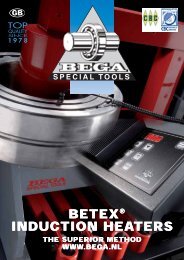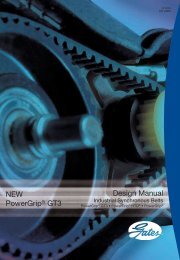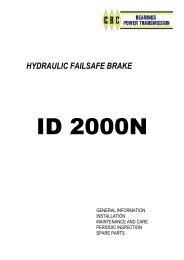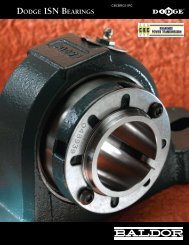Needle Roller Bearings - Ntn-snr.com
Needle Roller Bearings - Ntn-snr.com
Needle Roller Bearings - Ntn-snr.com
You also want an ePaper? Increase the reach of your titles
YUMPU automatically turns print PDFs into web optimized ePapers that Google loves.
Technical Data<br />
NTN<br />
11.3 Calculation Examples<br />
11.3.1 Shrinkage factor and post-installation<br />
clearance of drawn cup needle roller bearing<br />
The re<strong>com</strong>mended fit data for the standard bearings is<br />
as described in Table 1 on page B-33. This paragraph<br />
describes hereunder the calculation methods to be used<br />
when the bearing fit conditions are reviewed in detail.<br />
2) Inscribed circle diameter after <strong>com</strong>plete bearing fit<br />
in the housing on actual machine<br />
[1] Inscribed circle diameter in press-fitting of master ring<br />
T<br />
1) Calculation of bearing shrinkage factor<br />
For the drawn cup bearings, the shrinkage factor is<br />
calculated using the following method.<br />
H<br />
Fig. 11.5<br />
D<br />
DH<br />
Housing<br />
de<br />
Drawn cup bearing<br />
1S 2<br />
2t<br />
0.7S 2 1.31t 2 0.71.3t 2 1S 2 11.1<br />
E 2<br />
<br />
E 1 E 2<br />
Where,<br />
Outer ring shrinkage factor<br />
DH Housing outer diameter mm<br />
dnom Nominal diameter of fitting portion mm<br />
de Rolling surface diameter of outer ring mm<br />
E Modulus of housing vertical elasticity<br />
(Young’s modulus) MPa (kgfmm 2 )<br />
E Modulus of outer ring vertical elasticity<br />
(Young’s modulus)<br />
2.0710 6 MPa (21 200kgfmm 2 )<br />
dnom<br />
S <br />
DH<br />
de<br />
t <br />
dnom<br />
Fig. 11.4<br />
dnom<br />
H Housing inner diameter mm<br />
T <strong>Roller</strong> diameter + plate thickness mm<br />
D Outer diameter of drawn cup needle roller bearing mm<br />
Li Post press-fit inscribed circle diameter mm<br />
When the master ring is press-fitted, the dimension of<br />
"roller diameter + plate thickness" remains unchanged.<br />
Hence, the inscribed circle diameter Li is determined by<br />
the following formula.<br />
LiD2TDH1D2TH<br />
(11.2)<br />
Determine the mean value of "roller diameter + plate<br />
thickness" (=T) and standard deviation from formula<br />
(11.2). The mean value of formula (11.2) is determined<br />
as follows.<br />
mLi1mDm2TmH<br />
Standard deviation of formula (11.2)<br />
(11.3)<br />
Li212D22T 22H 2 (11.4)<br />
In the case of master ring, due to H 2=0 the formula<br />
(11.4) is expressed as follows.<br />
Li212D22T 2 (11.5)<br />
The unknown values in formulas (11.3), (11.5) are only<br />
mT and 2T 2 . Hence, substitute the known numerical<br />
values for formulas (11.3), (11.5) to determine m2T and<br />
2T 2 .<br />
[2] Even when bearing ring is press-fitted in the housing<br />
on actual machine, consider the inscribed circle<br />
diameter similarly to the master ring press-fit.<br />
Herein, the calculation formulas for press-fit in the<br />
housing on actual machine can be discriminated as<br />
follows from formula (11.3), (11.4) by adding " " to<br />
each formula.<br />
mLi1mDm2TmH (11.6)<br />
Li212D22T 22H2 (11.7)<br />
[3] For m2T and 2T 2 in formula (11.6), (11.7), substitute<br />
the values determined previously for the respective<br />
formula.<br />
[4] From the calculations, the inscribed circle diameter in<br />
press-fitting in the housing on actual machine can be<br />
A-54


